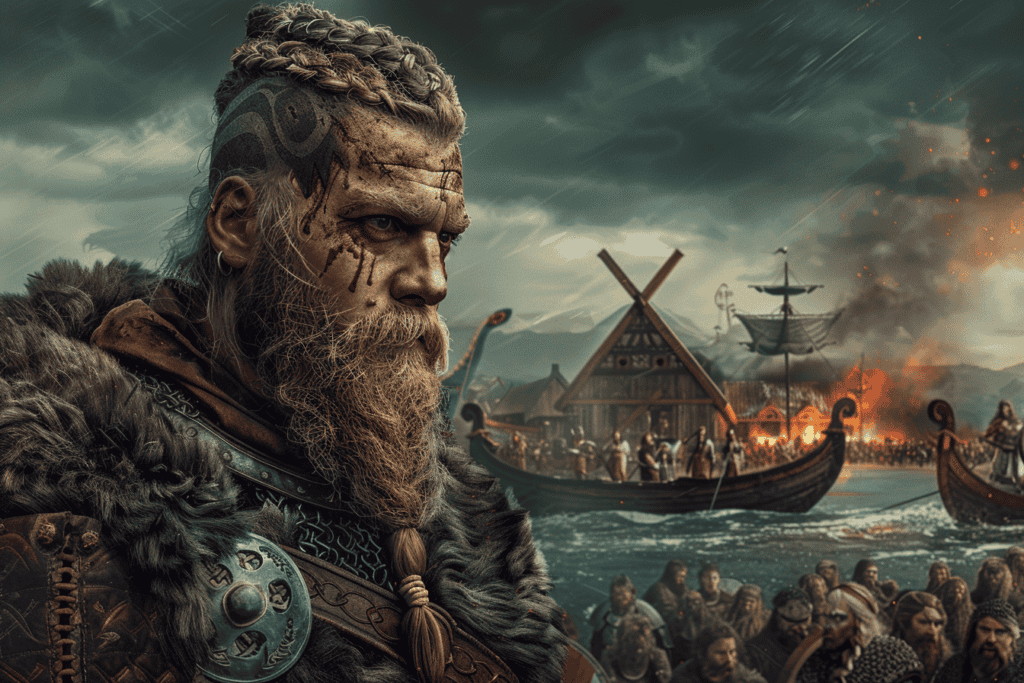The Swedish Viking King Björn Ironside’s death remains an enigma, with disparate accounts and speculations surrounding his final days.
Did he fall in battle, victim to a treacherous assassin, or succumb to the frailties of old age? The scarcity of historical records and the influence of mythological sagas have led to a tangled web of theories, making it challenging to discern fact from fiction.
As scholars continue to grapple with the circumstances of his demise, one question lingers: what secrets lie hidden behind the veil of Viking legend, waiting to be uncovered?
Unraveling the Mystery of Björn

During the Viking Age, the life and reign of Björn Ironside remained shrouded in mystery, sparking intense debate among historians and scholars.
Despite his significance as a Swedish Viking king, few reliable sources exist to illuminate his life and reign.
This scarcity of information has led to varied interpretations and disputes about his identity, achievements, and eventual demise. Björn’s anonymity has been further exacerbated by the lack of archaeological evidence and contradictory accounts from medieval sources.
The enigmatic nature of Björn Ironside has prompted historians to piece together fragments of information from disparate sources.
By analyzing the available records, they’ve attempted to reconstruct a plausible narrative of his life and reign. However, the inconsistencies and biases in these sources have made it challenging to separate fact from fiction. As a result, Björn’s biography remains a puzzle, with many questions still unanswered.
Despite these challenges, historians continue to scrutinize the available evidence, seeking to uncover the truth about this elusive Swedish Viking king.
Historical Records and Legends

Medieval records, though scarce and often contradictory, provide glimpses into Björn Ironside‘s life, with differing accounts emerging from the Anglo-Saxon Chronicle, the Frankish Annals, and Norse sagas.
These records offer a fragmented view of the Swedish Viking king, with each source presenting its own version of events.
The Anglo-Saxon Chronicle focuses on Björn’s raids and conquests, while the Frankish Annals provide insight into his diplomatic relations with European rulers. The Norse sagas, meanwhile, offer a more mythological account of Björn’s life, blurring the lines between history and legend.
Despite these contradictions, historians have been able to piece together a rough timeline of Björn’s life.
They agree that he was a powerful and influential leader, who ruled over Sweden and launched several successful raids on European territories. The historical records also suggest that Björn was a skilled military strategist, able to unite disparate Viking factions and forge alliances with other European leaders.
While the legends surrounding Björn’s life may be shrouded in mystery, the historical records provide a solid foundation for understanding the life and reign of this enigmatic Swedish Viking king.
Theories of a Violent Death

Björn Ironside’s death, shrouded in mystery, has sparked intense debate among historians and scholars, with many theories emerging about the violent nature of his demise.
One of the most popular theories is that he was killed in battle, possibly during a raid or an expedition. This theory is supported by the Viking warrior’s reputation as a fierce and fearless leader, who was known for his many conquests and military campaigns.
Another theory suggests that Björn Ironside was assassinated, possibly by a rival Viking chieftain or a political opponent. This theory is based on the idea that Björn’s power and influence would have made him a target for those seeking to overthrow him.
Some historians also propose that Björn Ironside may have died as a result of a violent revolt or coup within his own kingdom. While the exact circumstances of his death remain unclear, these theories offer a glimpse into the intricacies and dangers of Viking politics and warfare during the 9th century.
Alternative Accounts of Passing

Historical records also reveal alternative accounts of Björn Ironside‘s passing, which diverge from the violent demise theories. One such account suggests that Björn Ironside died of natural causes, perhaps related to old age or illness. This theory is supported by the Frankish Annals, which simply state that Björn died in 860 without providing any further details.
Another account, found in the Anglo-Saxon Chronicle, implies that Björn may have died in battle, but not in a violent or dramatic manner. Instead, it suggests that he may have succumbed to wounds or exhaustion following a military campaign.
These alternative accounts offer a more subdued and peaceful portrayal of Björn Ironside’s death, contrasting with the more sensational and violent depictions. While they may not be as dramatic or engaging, they provide a more nuanced and balanced understanding of the Viking king’s passing.
It’s essential to take these alternative accounts into account when reconstructing the life and death of Björn Ironside, as they add complexity and depth to the historical narrative.
Separating Fact From Myth

Determining the accuracy of accounts surrounding Björn Ironside’s death is a delicate task, as myth and fact often become intertwined in Viking legends. Historical records from the Viking Age are scarce, and those that exist are often biased or exaggerated.
The sagas, medieval Icelandic texts, offer valuable insights, but they were written centuries after the events they describe. It’s essential to approach these sources with a critical eye, recognizing that they may have been embellished or invented to serve a particular narrative or ideological purpose.
To separate fact from myth, historians must carefully analyze the available evidence, considering the cultural and historical context in which the stories were written. Archaeological findings, such as burial sites and artifacts, can provide valuable clues, but even these must be interpreted with caution.










Add Comment